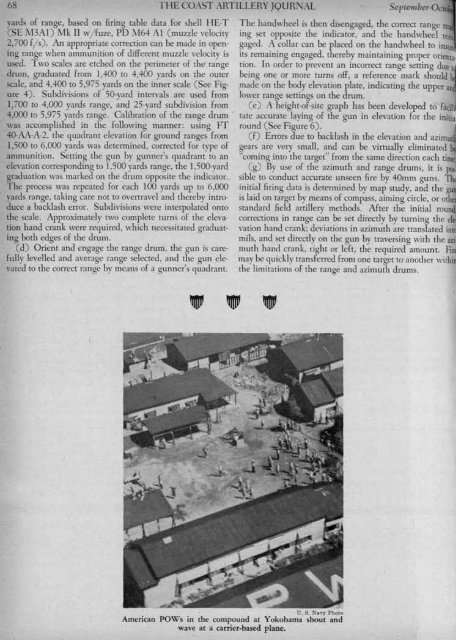September-October - Air Defense Artillery
September-October - Air Defense Artillery
September-October - Air Defense Artillery
Create successful ePaper yourself
Turn your PDF publications into a flip-book with our unique Google optimized e-Paper software.
68<br />
yards of range, based on firing table data for shell HE-T<br />
(SE M3AI) ~lk II w/fuze, PD M64 Al (muzzle velocity<br />
2,700 f/s). An appropriate correction can be made in opening<br />
range when ammunition of different muzzle velocity is<br />
used. Two scales are etched on the perimeter of the range<br />
drum, graduated from 1,400 to 4,400 yards on the outer<br />
scale, and 4,400 to 5,975 yards on the inner scale (See Figure<br />
4). Subdivisions of 50-vard intervals are used from<br />
1,700 to 4,000 yards range, ~nd 25-yard subdivision from<br />
4,000 to 5,975 yards range. Calibration of the range drum'<br />
was accomplished in the following manner: using FT<br />
40-AA-A-2, the quadrant elevation for ground ranges from<br />
1,500 to 6,000 yards was determined, corrected for type of<br />
ammunition. Setting the gun by gunner's quadrant to an<br />
elevation corresponding to 1,500 yards range, the 1,50o-yard<br />
graduation was marked on the drum opposite the indicator ..<br />
The process was repeated for each 100 yards up to 6,000<br />
yards range, taking care not to overtravel and thereby introduce<br />
a backlash error. Subdivisions were interpolated onto<br />
the scale. Approximately two complete turns of the eleva.<br />
tion hand crank were required, which necessitated graduating<br />
both ~dges of the drum.<br />
(d) Orient and engage the range drum, the gun is carefully<br />
levelled and average range selected, and the gun elevated<br />
to the correct range by means of a gunner's quadrant.<br />
THE COAST ARTILLERY JOllRNAL<br />
U. S. Nary Photo<br />
American PO\Vs in the compound at Yokohama shout and<br />
wave at a carrier-based plane.<br />
<strong>September</strong>-Octo<br />
The handwheel is then disengaged, the correct range r<br />
ing set opposite the indicator, and the handwheel ree<br />
gaged. A collar can be placed on the handwheel to insue<br />
its remaining engaged, thereby maintaining proper orienta<br />
tion. In order to prevent an incorrect range setting duej<br />
being one or more turns off, a reference mark should<br />
made on the body elevation plate, indicating the upper a<br />
lower range settings on the drum.<br />
(e) A height-of-site graph has been developed to faci!<br />
tate accurate laying of the gun in elevation for the initia<br />
round (See Figure 6). l<br />
(f) Errors due to backlash in the elevation and azimut<br />
gears are very small, and can be virtually eliminated b<br />
"coming into the target" from the same direction each time<br />
(g) By use of the azimuth and range drums, it is pos_<br />
sible to conduct accurate unseen fire by 40mm guns. The<br />
initial firing data is determined by map study, and the gu~<br />
is laid on target by means of compass, aiming circle, or othd<br />
standard field artillery methods. After the initial round<br />
corrections in range can be set directly by turning the ele<br />
vation hand crank; deviations in azimuth are translated intc<br />
mils, and set directly on the gun by traversing with the azi<br />
muth hand crank, right or left, the required amount. Fire<br />
may be quickly transferred from one target to another within<br />
the limitations of the range and azimuth drums.
















